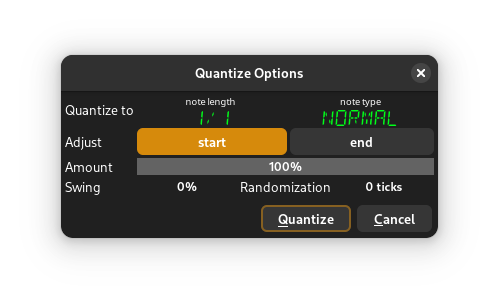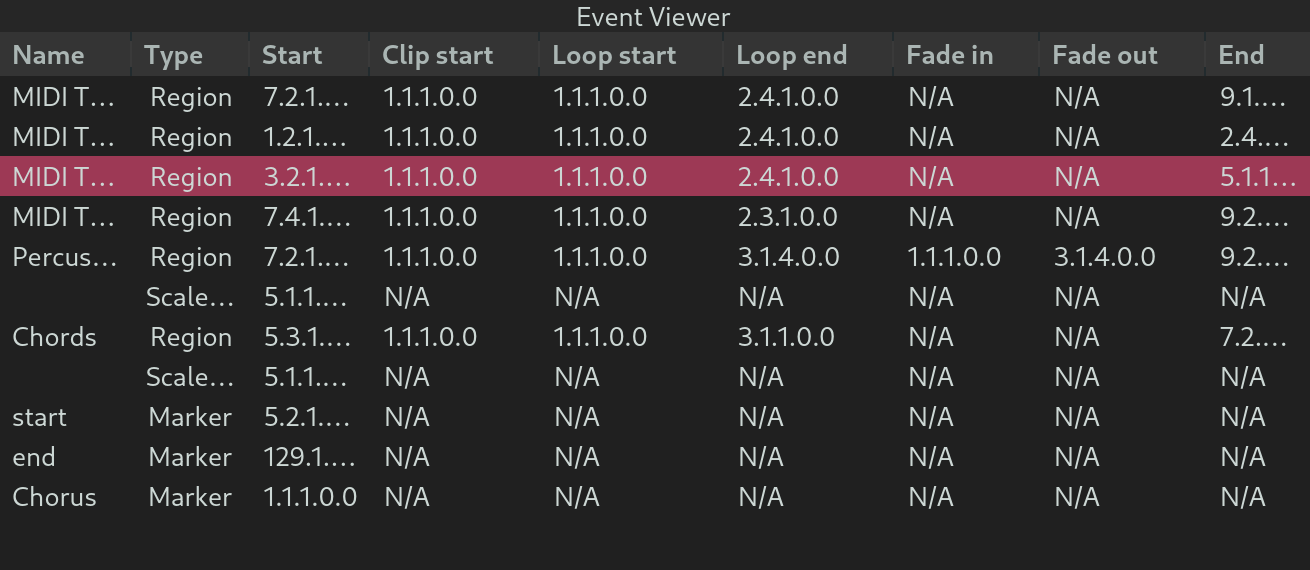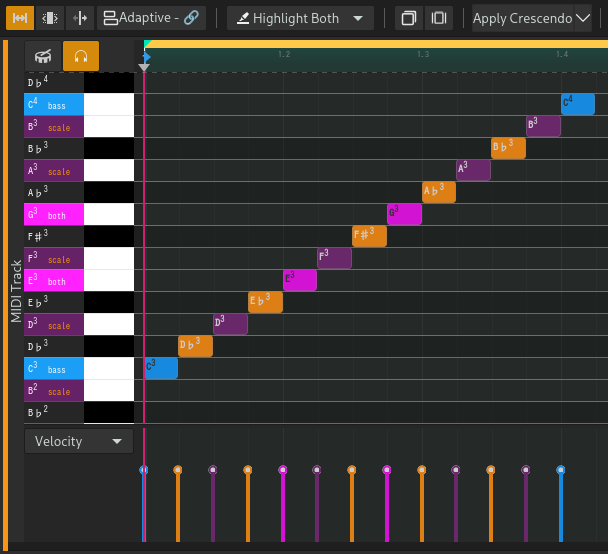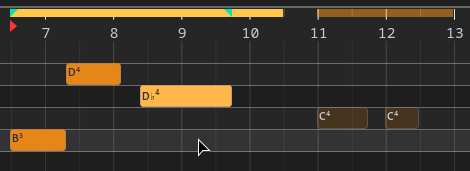Toolbar Options¶
Each editor (including the timeline) has a toolbar at the top with various options to ease editing.

Timeline toolbar¶
Opciones de cuadrícula y ajuste¶
This menu button allows adjusting snapping and grid display options.

Snap/Grid options¶
Each option is explained below.
- Position Snap
Turn snapping on or off.
- Adaptive Snap
Automatically adjust snapping behavior to the current zoom level, based on the selected note type.
- Snap to
Note size/length to snap to. This is only visible if Adaptive Snap is turned off.
- Tipo de nota
- Normal
Snap to the selected (or automatically determined) note length.
- Triplet
Snap to 2/3rds of the selected note length.
- Dotted
Snap to 3/2nds (1.5 times) the selected note length.
- Keep Offset
When snapping, keep the offset of objects from the nearest snap point on their left.
- Default Object Length
The length to use when creating new objects. The following options are available.
- Link to Snap
Use the same note length as the snap length above.
- Último objeto
Use the length of the last created object.
- Custom
Specify a custom length.
Cuantización¶
Los objetos se pueden cuantizar en posiciones específicas mediante las acciones Cuantizar y Cuantización rápida.

Cuantizar¶
Al hacer clic en el botón Cuantizar, se abre una ventana emergente que permite especificar la configuración para cuantizar la selección actual.

- Cuantificar a
Selecciona la duración y el tipo de nota para cuantizar.
- Ajustar
Selecciona si deseas cuantizar las posiciones iniciales, las posiciones finales (en objetos que tienen duración) o ambas.
- Cantidad
Seleccione la cantidad que se cuantizará. El 100 % cuantiza por completo las opciones especificadas, mientras que el 0 % no efectúa ninguna cuantización.
- Swing
Selecciona la cantidad de movimiento.
- Aleatorización
Aleatoriza las posiciones resultantes por la cantidad en tics, y es útil para incorporar un «sentimiento humano» a los eventos cuantizados.
Al hacer clic en Cuantizar, se realiza la cuantización y se guardan los ajustes para una cuantización rápida con Cuantización rápida.
Cuantización rápida¶
Realiza la cuantización basándose en los últimos ajustes conocidos.
Playhead Tracking¶
Zrythm includes functionality for forcing the playhead to remain inside the visibile area during playback.

Playhead tracking controls¶
- Scroll when Playhead Reaches Edge
Automatically scroll the visible area when the playhead moves outside it
- Follow Playhead
Keep the visible area centered at the position of the playhead
Escala¶
The timeline and each editor include horizontal (and sometimes vertical) zooming functionality.

Botones de escala¶
- Aumentar
Zoom in at the location of the playhead
- Disminuir
Zoom out
- Tamaño original
Zoom back to the default zoom level
- Mejor ajuste
Zoom in or out as much as required to show all of the events in the arranger
Visores de sucesos¶
Clicking the Toggle Event Viewer button will display an event viewer (or list editor) that shows all events in the corresponding editor as a list.

Visor de sucesos de la línea de tiempo¶
Sorting¶
Columns in the header row can be clicked to sort the events in ascending or descending order.
Edición¶
Some values can be changed by clicking in the corresponding field to enter edit mode, then pressing Enter when done.

Modo de edición¶
Selección de objetos¶
The object selection in the event viewer is linked to the arranger. This means that selecting objects inside the event viewer will also select them inside the arranger and vice-versa.
Timeline Controls¶
The following controls are only available in the timeline toolbar.
Range Operations¶
Range actions are performed on the selected range.
- Insert Silence
Insert empty space at the selected range and push all events in the range forward.
- Remove Range
Remove all objects inside the selected range and move events after the range backwards.
Fusión de objetos¶
Clicking this button will merge the selected regions. This button is deactivated when merging the currently selected regions is not possible.
The shortcut for object merging is Control-j.
Piano Roll Controls¶
The following controls are only available in the piano roll (MIDI editor).

Piano roll toolbar¶
Chord/Scale Highlighting¶
The highlighting option can be used to highlight notes corresponding to the scale, chord, or both at ther start position.
The position of the playhead will determine highlighting of the piano roll keys on the left side of the piano roll.

Resalte de escala y acordes¶
Separate colors are used, in order of priority based on the following:
The note is the current chord’s (if any) bass note
The note is both inside the current chord (if any) and the current scale (if any)
The note is inside the current chord (if any)
The note is inside the current scale (if any)
The note is neither in the current chord or scale, or there is no current chord or scale
Ver también
See the Chord Track, Chord Editor and Chord Pad for details.
Funciones de MIDI¶
MIDI functions are logic that can be applied to transform the selected MIDI notes. The following functions are available.
- Crescendo
Gradually increase the velocities of the selected notes from low to high. Used to create a climax.
- Flam
Create additional MIDI notes right after the start position of each selected note. This is usually used on snares.
- Voltear
Reverse/flip the selected notes horizontally or vertically.
- Legato
Connect all selected notes so that they play smoothly.
- Portato
Similar to legato, but leaves some space between the notes.
- Staccato
Make the selected notes short and punctuated.
- Strum Up/Down
Shift the position and velocity of notes that start at the same position (chords) to simulate strumming, like when playing guitar.
Por hacer
Add illustrations.
In the future, it will be possible to implement custom functions using user scripts.
Ghost Notes¶
By default, Zrythm will only display MIDI notes in the selected region. Clicking the mask buton will ghost (display with less opacity) MIDI notes from other regions in the same track.

Ghosted notes on the right¶
Clicking on a ghosted note will automatically switch the active/selected region to the clicked MIDI note’s parent region.
Automation Editor Controls¶
Funciones de automatización¶
Automation functions are logic that can be applied to transform the selected automation points/curves. The following functions are available.
- Voltear
Reverse/flip the selected automation horizontally or vertically.
Audio Editor Controls¶
Funciones de audio¶
Audio functions are logic that can be applied to transform the selected audio part. The following functions are available.
- Invert
Invert the polarity of the audio.
- Normalize Peak
Normalize the audio so that its peak is 0dB.
- Linear Fade In
Fade the audio from silence to full amplitude.
- Linear Fade Out
Fade the audio from full amplitude to silence.
- Nudge
Shift the audio by 1 sample backward or forward.
- Reverse
Reverse the audio (play back backwards).
- Programa externo
Run an external program (such as Audacity) to edit the audio.

Edit the selected audio in an external app¶
The selected program will be run with the path to a temporary file as an argument. Normally, the application will open that file, otherwise you will have to open it manually.
Consejo
Puede seleccionar y copiar la ruta en el diálogo.
Una vez que haya efectuado sus modificaciones en el archivo, cierre la aplicación externa y pulse en Aceptar. Zrythm aplicará los cambios a la parte seleccionada del audio.
Importante
La longitud del audio debe permanecer idéntica; de lo contrario, esta operación fallará.